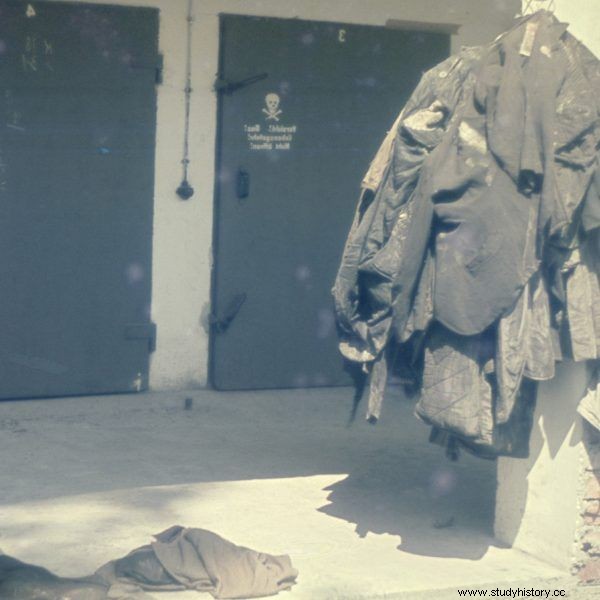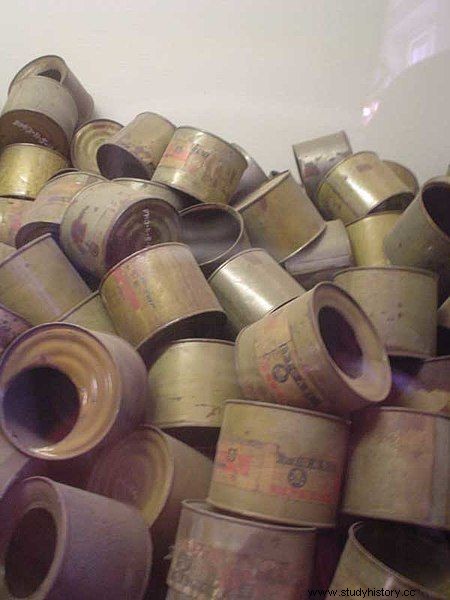Naked, crammed into narrow chambers, the victims died in terrible torments. Even for half an hour, the panicked people had to watch their companions perish one by one, until their agony was over as well. In this way, the Nazis "humanely" killed up to one million people.
Immediately after World War II, the Germans argued that death in the gas chambers was quick and painless. They were well aware, however, that Zyklon B is by no means humane. The agony of the condemned could last as long as half an hour. At that time, suffocating, crowded people were watering, dizzy and vomiting.
Looking at the death of fellow prisoners only intensified the attacks of anxiety accompanying the paralysis of the respiratory system. And yet among the murdered there were also tiny children (later, when the supplies of Zyklon B began to shrink, they were no longer led to gas - the commandant of the Auschwitz Birkenau camp decided to "burn the youngest prisoners to death among the burning corpses pulled from the gas chambers and poured with gasoline "... ).
But according to the Nazis, the Jews were only insects. And these must be disposed of - preferably with pesticides.

Fleeting tool of crime
What exactly was Zyklon B? This agent known from the end of the 19th century, produced by the German Degesch consortium, was in the form of diatomaceous earth lumps soaked in hydrogen cyanide. Under the influence of temperatures around 27 degrees Celsius, the lethal chemical compound transformed into a gas. This agent was sold under the trade name Zyklon B and was patented in the Weimar Republic.
In the 1920s, an eye irritant was added to the killer granules to warn people of a dangerous, colorless and poisonous gas. However, as Patricia Posner relates in her book The Pharmacist from Auschwitz:
Kurt Gerstein, who headed the SS Division of Technical Disinfection, insisted that Degesch remove the warning irritant from Cyclone B sold to the SS. (...) He presented the macabre details of using the company's product as a desirable genocide. He informed board members that the irritant had to be removed so that people about to be gassed would not be alerted at the last minute, which could cause widespread panic.
Even if the directors of Degesch had any moral qualms about obeying the order, they quickly got rid of them. Beginning in 1942 - largely due to orders placed by the SS for sky-high volumes of Zyklon B, the company's profits soared. Like the statistics of those murdered in gas chambers in concentration camps.

Before entering the gas chamber, the prisoners were ordered to undress. They were supposed to pick up their clothes after the "shower".
Holocaust test rabbits
Initially, Zyklon B was brought to Auschwitz for a completely innocent purpose - it was used to disinfect barracks and clothes. It was provided by the Testa company. Only after the conference of the highest-ranking SS men and heads of ministries in the government of the Third Reich, held at Wannsee on January 20, 1942 , Cyclone B became an instrument of mass extermination. Its operation had been tried before - though still uncertainly.
The first human experiment with the use of a pesticide was carried out during World War II, probably on September 3, 1941 in the main camp at Auschwitz Birkenau. The "test rabbits" gassed in the cell of Block 11 were Soviet prisoners of war and Polish prisoners. Robert Moorhouse describes:
This first test did not look very promising. As the Polish prisoner August Kowalczyk recalled, the next morning some of the victims were still alive, which was caused by the use of insufficient amount of Zyklon B or its escape through cracks in the walls. Nevertheless, another trial was soon carried out, this time in the presence of the camp commandant, Rudolf Höss.
This and the following approaches to the "Final Solution of the Jewish Question" have proved to be much more effective.
Victor Capesius, the chief pharmacist at the camp, responsible for the pesticide deliveries to Auschwitz, had his hands full. Especially since he not only brought Zyklon B to the camp pharmacy. Patricia Posner in the book The Pharmacist from Auschwitz relates:
According to the account of Fritz Peter Strauch, a Jewish prisoner and pharmacist who was one of Capesius' most trusted assistants, the Zyklon B that Capesius stored did not contain warning measures or was not labeled. Degesch produced this batch solely for the purpose of gassing people.

A stack of empty containers from the Auschwitz camp
But Capesius was more than just the keeper of the poison warehouse. Other witnesses have seen that he plays a much more direct role in the extermination machine, personally delivering the deadly cyclone b container to the gas chambers.
Death with the scent of almonds
When the criminal procedure was successfully perfected, the executions went smoothly. Prisoners to be killed were led to the gas chambers (often pretending to be bathrooms with showers) and ordered to undress. The sealed door was then closed behind them and poisonous pellets were thrown through an opening in the wall or ceiling. Then it was enough to "clean up" the bodies.
What was Zyklon B doing with the victims? As Roger Moorhouse describes:
The pesticide decomposed into a gas under the influence of heat and moisture. People closest to the hole through which the lethal agent was poured died within minutes; the people standing still died a little later.
All victims experienced unconsciousness first and then cardiac arrest. According to the accounts of witnesses, after about 15 minutes, no one was left alive in the chamber. The bodies of the killed often showed pink discoloration, and sometimes also blue stains.
Hydrogen cyanide leads to the so-called internal suffocation, as it blocks the exchange of oxygen from red blood cells and interferes with tissue respiration. It is also very efficient. As Rudolf Höss testified after the war, 5-7 kg of the pesticide was enough to murder 1,500 people.

As Moorhouse lists: “In total, the Germans killed about a million people this way, mainly in Birkenau. This one camp alone used as much as 24 tons of Zyklon B from 1942 to 1945 ” . The last time the container with Zyklon b was used in the Auschwitz camp on November 2, 1944.
